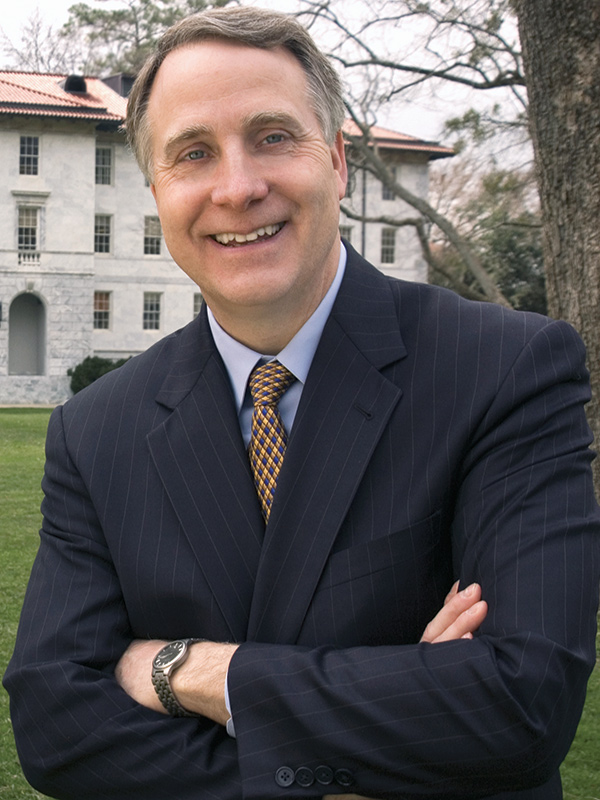From the President
Is Higher Education Sustainable?

As this issue of Emory Magazine makes wonderfully clear, Emory has made great strides toward meeting our shared goal of being the most efficiently “sustainable” campus we can be. A larger question lurks on the margins, however—while the campus may be sustainable, is its purpose? In other words, how sustainable is the model of higher education that Emory shares with a great many institutions in the United States?
No one can remain oblivious to the chorus of voices suggesting that American higher education is sailing in rough seas. Universities are widely acknowledged as our nation’s most attractive resource and the repository of much of our commonwealth’s trust. But they are facing a stiff headwind of resistance to increasing tuition, the economic downturn has depleted the ballast of many endowments, and the wild currents of changing technology have challenged our navigational systems. To add to the complexity, our passengers increasingly want us to get to the port called “a job” as soon as possible.
In assessing these challenges, my administrative colleagues and the trustees have come to share a particular point of view about the foreseeable future of higher education. Let me share with you four key conclusions.
First, generalizations belie the complexity of higher education. In other words, the diagnoses and prescriptions for the ailing patients in the higher education ward (to change the metaphor) will not fit everyone. The higher-education “industry” is richly varied, ranging from research-intensive universities like Emory to two-year community colleges, and from for-profit institutions like the University of Phoenix to traditional not-for-profit places like us. Of some forty-six hundred institutions of higher education in the US, only 108 are research universities like Emory, and of those only sixty-two (including Emory) belong to the Association of American Universities, whose members produce the overwhelmingly largest share of discovery and new knowledge.
Although membership in our particular segment of higher education does not render us immune to the disruptions of our times, clearly, Emory and our peers must not act from sweeping generalizations about “higher education.” Instead, we must make decisions and take steps based on our place within that quite diverse array of institutions.
Second, research universities will become more, not less, important in the twenty-first century. Advances in information technology, drug discovery, health care, new energy, and other critical forms of knowledge will continue to depend on basic research and its translation into useful applications, and no one does this better than research universities. These institutions have long been, and will long be, crucibles for discovery and improvement of the human condition. For this reason alone, the kind of education provided by research universities will hold its value.
Research universities will become still more important for a second reason—their capacity for sorting valuable information from chaff. The information explosion will require reliable judgment about how to synthesize, validate, and disseminate trustworthy information, so that it can become useful knowledge on the basis of rational analysis. This is the work of universities, and it will remain indispensable.
Third, and unfortunately, our point of view acknowledges that research universities will face profound financial stress in the foreseeable future. Downward pressure on tuition, on research funding, and on reimbursements for the clinical services provided by the health care arm of our health sciences education—all of these indicate that we must control costs and reenvision our financial models. This is particularly true in Emory College of Arts and Sciences and in the School of Medicine, our largest and most complex schools, which also happen to be most vulnerable to the current financial stressors.
Fourth—and fortunately—the future offers great opportunities. For instance, we already have begun to identify new revenue-producing activities that Emory can undertake without in any way diminishing our important values and our long-established character. We also believe that global demand for American higher education will continue to increase—especially for the sort of liberal arts education in a research university that is one of the hallmarks of Emory.
Yet another opportunity is the prospect of developing a growing base of passionate lifetime supporters. Just as Emory has nurtured a strong and loyal family of alumni for decades, we see ways of reaching beyond that traditional base for a larger pool of advocates worldwide. We know from recent experience—our collaborations with Georgia Tech, our partnerships in India, our exploration of institutional ties in Asia and Africa—that great possibilities exist for strong domestic and international partnerships.
In short, this moment in higher education beckons us to build on Emory’s traditional strengths to meet the emerging challenges of our time. In my next column I will outline more specifically where I think this point of view might lead us as we continue to move Emory forward. Stay tuned, and come along.



